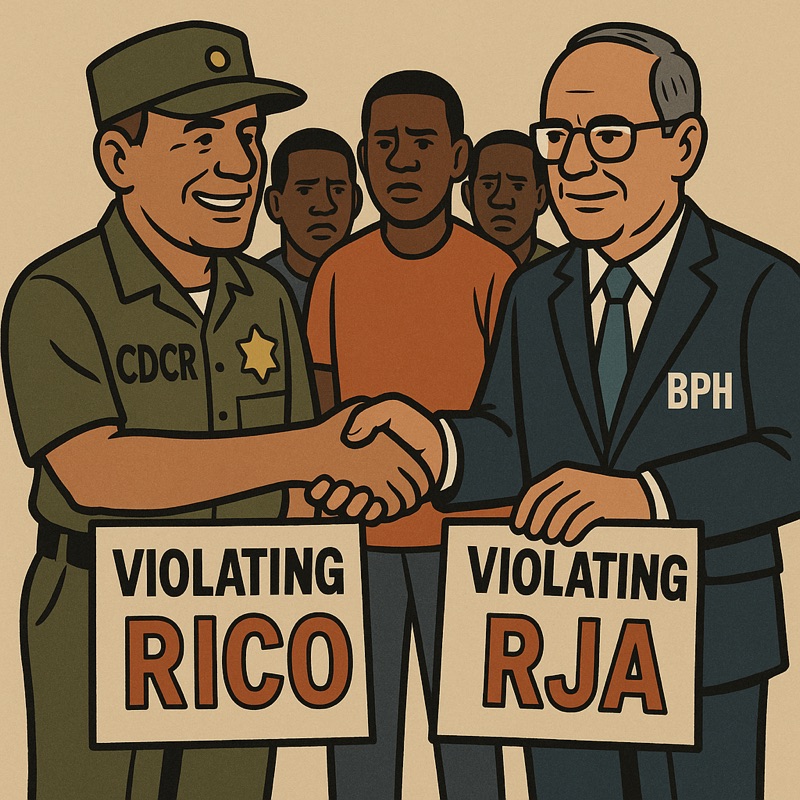
Inside the Custody Machine: How CDCR and BPH Turned Justice into a Business
By Devon T. White
Special to ThaWilsonBlock Magazine
I. The Crime Behind the Walls
California’s correctional system has perfected a quiet crime. Behind polished mission statements and re-entry slogans, the California Department of Corrections and Rehabilitation (CDCR) and the Board of Parole Hearings (BPH) have withheld thousands of men and women beyond the lawful limits of their determinate sentences.
The law is not vague. Penal Code § 3000(a)(1) commands a mandatory kick-out—release to parole supervision—once the determinate term has been fully served. Penal Code § 3000(b)(1) makes clear that the purpose of parole is transition, not confinement: a period when parolees are “afforded educational, vocational, family, and medical resources.”
Yet CDCR and BPH have inverted the statute. Instead of releasing people, they imported parole programs into the prison itself—creating in-custody “vocational,” “educational,” and “counseling” modules that mimic community supervision. This maneuver sustains prison populations, inflates budgets, and disguises continued imprisonment as rehabilitation. It is, by definition, false imprisonment under color of law.
II. The Elite Officials and Their Explicit Behavior
The elite officials of CDCR and BPH have exhibited explicit, coordinated behavior in withholding people beyond their lawful determinate terms. These agencies know full well that Penal Code § 3000(a)(1) establishes a mandatory release to parole supervision after the determinate term has been served. Despite that statutory command, CDCR and BPH have boldly and recklessly engaged in racketeering behavior, forming what amounts to a false governmental entity that profits from unlawful custody.
By introducing vocational, medical, educational, and counseling programs inside prison walls, CDCR and BPH have created a self-funded economy—profiting off their own loans, budgets, and contracts. Under the law, those programs belong to the parole phase—the stage after release. But rather than letting individuals transition, the departments built a commercial rehabilitation market behind bars, violating the Separation of Powers Doctrine and collapsing the independent and subordinate jurisdictions that the law requires.
The result is systemic: people are being held past their lawful release dates, amounting to false imprisonment and misuse of public funds. When challenged, CDCR and BPH cannot produce even a wet-ink signature authorizing continued custody after the determinate term expires. That absence is proof, evidence, and irrefutable discovery of unlawful detention—supported by statutory authority that cannot be ignored.
III. Defrauding the Federal Government
Federal agencies allocate millions in grants for parole transition, workforce training, and medical reintegration. Those funds are meant for individuals released under parole supervision—not prisoners still behind bars.
By reporting in-prison programming as “parole services,” CDCR and BPH have defrauded the federal government. This conduct implicates:
- 18 U.S.C. § 641 – Theft or conversion of federal funds
- 18 U.S.C. § 1001 – False statements and concealment
- 18 U.S.C. § 1343 – Wire fraud
- 18 U.S.C. § 1962 – Racketeer Influenced and Corrupt Organizations (RICO) violations
Each falsified report or budget entry showing “active parole programs” inside prison walls represents another act of federal fraud—a pattern that satisfies the elements of racketeering under U.S. law.
IV. Defrauding the Taxpayers
Taxpayers fund both the prisons and the supposed “re-entry” programs that never leave them. The lead officials of CDCR and BPH have engineered a dual-funding stream—charging the public twice while pocketing institutional gains.
By maintaining artificial prison populations and disguising incarceration as rehabilitation, the agencies convert liberty into revenue. Every unlawfully detained person equals another contract, another job preserved, another budget expansion justified. In economic terms, false imprisonment has become a business model.
V. Violated United States Codes and Statutes
| Area of Law | Statutory Citation | Violation Description |
| Civil Rights | 18 U.S.C. § 242 ; 42 U.S.C. § 1983 | Deprivation of liberty under color of law |
| Racketeering | 18 U.S.C. § 1962 (a)–(d) | Enterprise profiting from illegal detention and fraud |
| Mail & Wire Fraud | 18 U.S.C. § 1341 ; § 1343 | False reporting to obtain government funding |
| False Claims | 31 U.S.C. § 3729 et seq. | Submitting claims for services not legally provided |
| Theft of Funds | 18 U.S.C. § 641 ; § 666 | Misappropriation of federal or state program money |
| State Penal Code | Cal. Penal Code § 3000 (a)(1)–(b)(1) ; § 669 | Holding inmates beyond determinate terms; jurisdictional overreach |
VI. The Irrefutable Proof
Ask CDCR or BPH for the wet-signature authorization extending anyone’s imprisonment past their determinate term. They cannot produce it—because none exists. That void signature trail is not oversight; it’s the legal fingerprint of fraud. It reveals a pattern of false imprisonment sustained by silence, policy, and profit.
VII. A Call for Accountability
California’s citizens and policymakers must confront this corruption head-on. The statutes are clear, the evidence is tangible, and the victims are living it every day. The mandatory kick-out clause of Penal Code § 3000(a)(1) is not a bureaucratic option—it’s the law. Each day that CDCR and BPH ignore it, the state’s correctional apparatus deepens its complicity in racketeering, human rights violations, and economic fraud.
It’s time for transparency. It’s time for release. It’s time to restore the rule of law behind the walls that have hidden its betrayal for far too long.
© 2025 Devon T. White | ThaWilsonBlock Magazine — All Rights Reserved.


Comments
Post a Comment